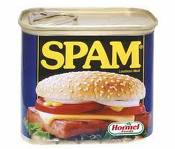 |
| George A. Hormel |
George A. Hormel, the founder of Hormel Foods, opened a small retail butcher shop in Austin, MN, on May 16th, 120 years ago, a mere seed of what was to germinate. At the same time, he fertilized grand plans for an innovation which broke ground in the pork-packing business – a manufactory plant of high-quality processed-meat products.
Hormel (1860-1946) started his professional life as a paperboy, and soon graduated to 14-hour days in a meat-packing plant in Chicago, a tough school by any standards. This rigorous grind annealed his imagination and sense of enterprise. Hard work, innovation, and remarkable marketing skills resulted in success beyond even his dreams, and made his name familiar in every household.
Within twenty years, George A. Hormel and Company was known nationally. By World War I, the company’s exports “accounted for 33% of the company’s yearly volume.” (2) Hormel’s son Jay became president in 1929, and he shared his father’s business knack and daring. Although various meat products had been canned since the mid-1800s, ham in a can had not been seen until Hormel introduced it. Hormel even sponsored a women’s drum-&-bugle corps which toured the country promoting Hormel products. (1)
Hormel’s most famous product, SPAM, a luncheon meat, “was introduced in 1937 and achieved an 18 percent market share within the year.” (1) It became a staple item in the ration kits for soldiers during World War II. According to Hormel’s website, the company sent 15 million cans of luncheon meat to troops every week. No small peanuts! World leaders showered Hormel with accolades for this contribution to the war effort. (1) Soldiers may have become jaded with the monotony of rations, but nevertheless, SPAM was a far superior option to starvation.
Since then, hundreds of Hormel products under many brand names have become popular throughout the world, by the dynamic marketing of quality goods.
 |
| SPAM Museum in Austin, MN |
Hormel, still located in Austin, MN, opened the SPAM Museum in 2001, which over 20,000 SPAM lovers visit every year. It is obviously our loss that my husband and I, traveling to South Dakota in 2004 with three other family members, did not stop in as we passed by on the highway – I can only imagine that it must be as entertaining and fascinating as the Corn Palace in Mitchell, SD, which is worth the visit. Then again, we also failed to visit the Jell-O Museum/Gallery in Le Roy, NY, as we passed through, which probably has an equal appeal to those who revel in gustatory curiosities.
 |
| “Monty Python’s Flying Circus” Spam sketch |
SPAM has provided everyone with far more than nutrition over the decades. On an episode of “M*A*S*H,” in order to save Radar’s pet lamb from the dinner table, the cooks fabricated an Easter lamb with SPAM to serve to Greek soldiers. Monty Python’s Flying Circus has had more than one successful production spoofing SPAM: first they created a sketch about SPAM as the only thing on a restaurant menu; and “Spamalot,” a hit Broadway musical mash-up, is still in production in various parts of the world. I’m sure that innumerable other instances abound of SPAM spoofing, to say nothing of everyone’s personal adventures with the stuff, like the small can of SPAM which often shows up in my husband’s Christmas stocking. It’s like the Christmas fruitcake – it’s the same can, year after year.
I don’t know if modern email “spam” is so-called after the exponential proliferation of SPAM products worldwide or after the popular perception that the product suffers from comestible ennui. Probably both. But whether or not we make fun of it, you can’t argue with success. Hormel has cornered that market.
Good, bad, or indifferent: when you need a SPAM fix, there’s just nothing like a fried SPAM sandwich!
(1) Hormel Foods http://www.hormelfoods.com/about/history/historyOfInnovation.aspx
(2) Wikipedia: Hormel http://en.wikipedia.org/wiki/Hormel




